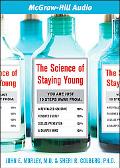

 |

|

The average rating for The Science of Staying Young based on 2 reviews is 2.5 stars.
Review # 1 was written on 2011-05-08 00:00:00 Jackie Isamay Jackie IsamayNot bad |
Review # 2 was written on 2013-05-05 00:00:00 Gregory S Karmel Gregory S KarmelChairman: You read in several languages, you are familiar with higher mathematics and can perform all manner of work. Do you think that this makes you human? Otark: Yes, of course. Do humans know how to do anything else? From “A Day of Wrath" by Sever Gansovsky ‘Path into the Unknown: The Best of Soviet SF’ is a small anthology which is best described as a sliver of time. It is a historical artefact from the ‘Thaw’ period of the post WW2 Soviet Union, which roughly coincided with the Premiership of Nikita Khrushchev, during which Soviet writers and other artists were given licence to explore themes and take up issues that would have been impossible under Stalin. By the time this anthology was published in the West however (1966), the Thaw period was definitely over. Khrushchev had lost power to Leonid Brezhnev in 1964, and in 1965 the notorious trial of the writers Yuli Daniel and Andrei Sinyavsky began. Sinyavsky–Daniel was the first Soviet show trial in which writers were charged and convicted solely for their literary work, and was intended as a signal to other artists that a period of relative freedom was at an end. For the writers in this collection the Trial would have been particularly significant because Sinyavsky and Daniel were targeted for having been published abroad. ‘Path into the Unknown’ was published by Pan, and edited by the US/Canadian SF writer Judith Merril (although on this edition the editor is not named). Merril was a long standing Anti-Vietnam War, and later Anti-nuclear activist, so she would have been keen on building bridges to Soviet writers. This is not a ‘best of … ever’ anthology, rather it is a selection of the most recently written (at the time) Soviet SF. Therefore the qualities of the stories are a bit uneven, and possibly suffering a little in translation. Nevertheless familiar themes of Western SF are covered: robotics, space travel, genetics, extraterrestrial life, etc. There are two stories by the brothers Arkady and Boris Strugatsky (‘An Emergency Case’, and ‘Wanderers and Travellers’) who are probably the most well known writers in the West - their novel ‘Roadside Picnic’ was made into the film ‘Stalker’ by director Andrei Tarkovsky in 1979. Others such as Sever Ganovsky (‘A Day of Wrath’) I had not heard of before. The Soviet era was the ‘golden age’ of science fiction in Russia at least, as the genre experienced an precedented growth in popularity. In the 1920s major theme was social reconstruction, befitting the immediate revolutionary times. As Stalin secured power the options for SF writers (as with others) became far more constrained, although the scientific and technological optimism within science fiction did chime with the USSR’s ‘world-building’ priorities of industrial development. However in the post-Stalin ‘Thaw’, the possibilities of the genre as an artistic laboratory for different ideas about society and history began to be taken up. You can see them being played out in this collection, even though the writers are careful to avoid direct political references. One example is Gansovsky’s story ‘Day of Wrath’, in which a biological experiment has created human-like creatures (the ‘Otarks’) who have superior intellectual abilities in areas such as mathematics, but nevertheless terrorize the countryside, killing and eating not only humans but also each other. Gansovsky’s human characters spend much of the story speculating about what makes us ‘human’ at all. The Otarks menacingly tease humans with the argument that they should also be considered human as well, because they can perform all the higher intellectual functions that humanity claims to prize. Gansovsky (who ‘capitulated’ to the Soviet state later in life) may be satirising the assumptions behind the USSR’s ostensible goal of ‘building Soviet Man’. The USSR put huge resources into educational outcomes - particularly technical and scientific ones. However it also expected the Soviet citizens to be ruthless in their ‘defence of the revolution’ - turning on comrades, friends, and family whenever the need arose. Given that the Stalinist purges of the 1930s were still a living memory in the 1960s, the Otarks can be seen as ‘Soviet Man’ fully realised - and no longer human at all. |
CAN'T FIND WHAT YOU'RE LOOKING FOR? CLICK HERE!!!